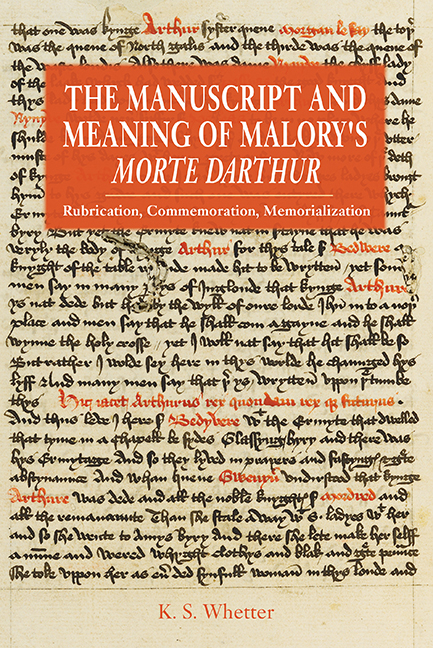Book contents
- Frontmatter
- Dedication
- Contents
- List of Plates
- Acknowledgements
- Abbreviations
- A Note on the Text
- A Textual Introduction
- 1 The Unusual Nature of Winchester's Rubrication
- 2 Tracing Winchester's Rubrication and Marginalia
- 3 Malory's Sacralized Secularity
- 4 Rubricated Elegy
- Conclusion: The Red and the Black
- Bibliography
- Index
- Miscellaneous Endmatter
Conclusion: The Red and the Black
Published online by Cambridge University Press: 28 April 2017
- Frontmatter
- Dedication
- Contents
- List of Plates
- Acknowledgements
- Abbreviations
- A Note on the Text
- A Textual Introduction
- 1 The Unusual Nature of Winchester's Rubrication
- 2 Tracing Winchester's Rubrication and Marginalia
- 3 Malory's Sacralized Secularity
- 4 Rubricated Elegy
- Conclusion: The Red and the Black
- Bibliography
- Index
- Miscellaneous Endmatter
Summary
Karen Cherewatuk, in her influential reading of Launcelot's death, follows ‘fifteenth-century bishop and theologian Reginald Pecock’ in emphasizing ‘that a [mediaeval] Christian learns the stories of the saints “bi calling in to mynde what he hath bifore thilk day red or herd red in book, or herd prechid, or seen peinted”’. This is quite true, and Cherewatuk is justified to claim that Malory and his contemporaries would have assimilated doctrinal and hagiographic knowledge alike when sitting in church. It is equally true, however, that a mediaeval lay person could likewise read, hear and see the deeds of more secular and chivalric exemplars and that this chivalric engagement occurred equally in churches, cathedrals and abbeys as in castles and manor houses. Indeed, the iconography of mediaeval religious buildings regularly juxtaposed Christian with chivalric images, sacred with secular; even stained glass might commemorate knightly status or genealogy. The tombs and effigies of the armigerous classes, gentry and nobility, likewise visually emphasize knightly deeds, brotherhoodin- arms and chivalric pedigree. Chivalric culture and chivalric memory were thus closely imbricated, more so even than chivalry and Christianity. As Nigel Saul illustrates, chivalry accordingly.
generated a rich repertory of contemporary witness: tombstones and tomb effigies, funerary armour, objects associated with legendary heroes, armorials on walls and in windows, rolls of arms, biographies and family chronicles. Chivalry was found in the landscape, in churches, in baronial halls, even in abbey refectories. … The memory of chivalry lived on in the culture which it created, and that culture was at once visual, physical and literary.
Caxton utilizes this expectation that a mediaeval person would see and value chivalric trappings in the justification he puts in the mouths of his ‘noble and dyvers gentylmen’ in the preface to the Morte Darthur, where Arthur's historicity is said to be verifiable on the basis of considerable tangible evidence. Caxton's – or his interlocutors’ – evidence includes Arthur's ‘sepulture in the monasterye of Glastyngburye’, and the ‘many remembraunces … of hym’ that may yet and will forever be seen in England, including Arthur's seal at Westminster Abbey, Gawayne's skull at Dover Castle, the Round Table at Winchester, and ‘Launcelottes swerde and many other thynges’.
- Type
- Chapter
- Information
- The Manuscript and Meaning of Malory's Morte DarthurRubrication, Commemoration, Memorialization, pp. 215 - 230Publisher: Boydell & BrewerPrint publication year: 2017



